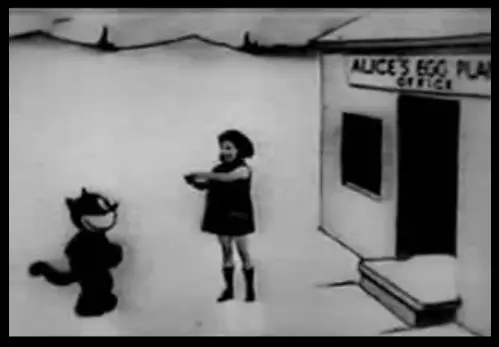Before Mickey Mouse and Oswald the Lucky Rabbit, Julius the Cat was one of Walt Disney’s earliest animated characters. Julius debuted in 1922 in the Alice Comedies, Disney’s first animated series. However, his roots trace back even further to the Laugh-O-Gram shorts, where cats, including the star of Puss in Boots, served as inspiration.
Julius is an anthropomorphic cat, reminiscent of Felix the Cat, with a bold and inventive personality. As the Alice Comedies progressed, Julius became the central character, leading Disney to shift from live-action to full animation for future projects. While Oswald and Mickey would later steal the spotlight, Julius remains an important figure in the history of Disney animation, representing the early creativity and experimentation of Walt Disney and Ub Iwerks.
One of Walt Disney’s favorite gags was the “nine lives” gag, where a cat character would have a mishap, and its spirit would exit its body nine times. This humorous routine first appeared in the cartoon “Little Red Riding Hood” and later resurfaced in the “Puss in Boots” cartoon. However, a twist was added in the latter: a man would prevent one of the spirits from leaving, pulling it back down to the cat before reaching the ninth escape.
These films hold significance as they introduce a cat character resembling Julius in the Disney canon. Although it’s uncertain whether the cat was actually Julius, as it was never explicitly named, the design of the Laugh-O-Gram cat closely mirrors Julius’s appearance in later works. This continuity suggests a thematic connection and evolution of character design within Disney’s early animation endeavors.
Julius the Cat and Felix the Cat
Julius the Cat and Felix the Cat share an uncanny resemblance, with Julius being reminiscent of Felix, a beloved character from the early 1900s. Felix, created by Pat Sullivan and distributed by M.J. Winkler Pictures, was a prominent figure during the silent film era. However, Felix’s popularity waned as the animation industry evolved to incorporate sounds and voices.
When Walt Disney’s work was picked up by Winkler Pictures, Charles Mintz, the distributor, preferred Julius over Felix despite their striking similarities. Despite Felix’s established presence since 1919, Julius gained favor with Mintz after Disney’s collaboration. This shift led Pat Sullivan to terminate the distribution contract with Winkler Pictures.
Felix’s decline continued as Mickey Mouse became a cultural icon, capturing the public’s attention. Disney’s Silly Symphonies also marginalized Felix’s presence in the animation landscape, leading to his eventual phasing out by 1930.
Avid Writer with invaluable knowledge of Humanity!
Upcoming historian with over 30 million views online.
“You make your own life.”





